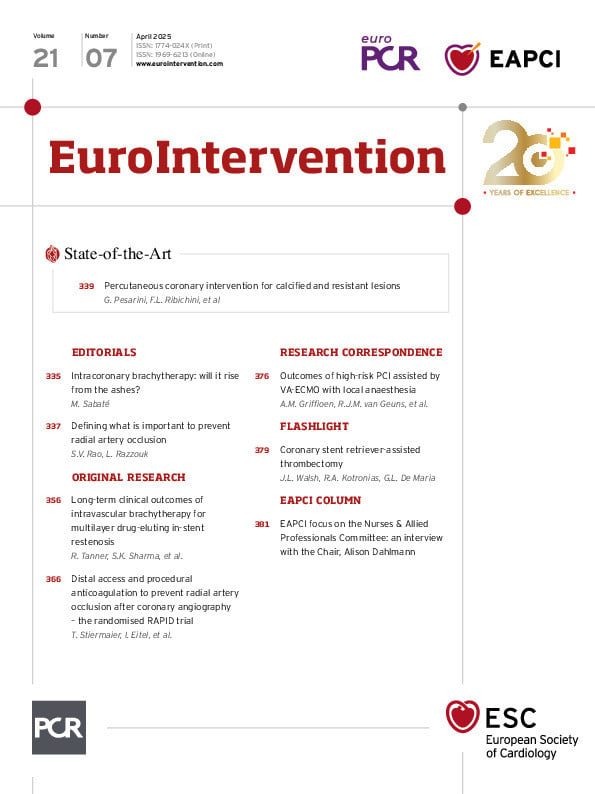Cory:
Unlock Your AI Assistant Now!
The use of transradial artery access (TRA) for diagnostic coronary angiography and percutaneous coronary intervention (PCI) has steadily increased over the last two decades globally, becoming the recommended site of vascular access across the whole spectrum of coronary artery disease, with a reduction in major bleeding and vascular complications when compared with femoral access12. Radial artery occlusion (RAO) after transradial procedures varies widely from 0.8% to 30%, and is caused by trauma to the arterial wall, leading to changes in the endothelial function and neointimal hyperplasia, along with acute thrombus formation at the access site3. The use of distal transradial artery access (dTRA) might mitigate trauma to the proximal segment of the artery – a systematic review of over 9,000 patients demonstrated that dTRA is safe and feasible for coronary diagnostic and interventional procedures, with shorter haemostasis time and a lower incidence of any bleeding, RAO and pseudoaneurysm when compared with conventional TRA (cTRA)4. Patent haemostasis has been associated with a reduction in the rate of RAO5, and the PHARAOH study demonstrated that a provisional approach to anticoagulation (AC) was associated with similar RAO rates as routine procedural AC6. There are limited data, however, on patients on pre-existing AC who undergo cTRA or dTRA and receive additional systemic AC, and limited data on the differential benefit of systemic AC in cTRA as compared with dTRA.
In this issue of EuroIntervention, Stiermaier and colleagues report the results of a trial comparing dTRA and cTRA, with or without periprocedural administration of AC, in a 2x2 factorial design in patients undergoing diagnostic coronary angiography7. The primary endpoint of the study was ultrasound (US)-assessed RAO prior to discharge from the hospital. The study participants received heparin bolus at 50 IU/kg (intra-arterial or intravenous) or bivalirudin with a weight-based bolus and infusion during diagnostic coronary angiography, in a single centre in Germany between February 2020 and May 2023. Patients undergoing percutaneous coronary intervention (PCI) were excluded as they routinely received systemic AC during their procedure. The trial aimed to enrol 1,200 patients with prespecified interim analyses and was terminated at the second interim analysis with inclusion of 439 study participants, and exclusion of 161 patients who underwent PCI.
Enrolment was ended early due to the large difference in the primary endpoint of the procedural AC group in reducing the rate of RAO (7.3% vs 33.9%; p<0.001), without a statistically significant increase in bleeding (7.3% vs 3.6%; p=0.087). There were also no differences in bleeding (4.1% vs 6.9%; p=0.188) or RAO (20.3% vs 21.2%; p=0.810) between dTRA and cTRA, respectively, but there was a higher risk of minor bleeding (Bleeding Academic Research Consortium 1-2) in participants receiving AC and undergoing cTRA (11.7% vs 2.6% for dTRA; p=0.009). Consistent with prior studies comparing conventional to distal TRA, dTRA was associated with significantly more puncture attempts and a higher rate of crossover to cTRA/femoral access (14.9% vs 8.3%; p=0.032), with a longer procedural time (25 mins vs 20 mins; p=0.001) than cTRA.
The investigators acknowledge the limitations of a single-centre design and early termination after enrolment of half of the intended study population, as this may impact the statistical significance of some of the outcomes, such as the difference in RAO rates between dTRA and cTRA in patients receiving periprocedural AC. Furthermore, the COVID-19 pandemic affected the enrolment rate in the study. Current best practices to maintain radial artery patency after instrumentation and minimising radial artery wall trauma include adequate anticoagulation, use of non-occlusive haemostasis and timely removal of compression devices8. The lack of standardisation of periprocedural strategies in the trial, including local anaesthesia, systemic analgesia, routine use of intra-arterial vasodilators, and possibly the use of standard, rather than thin-walled introducer sheaths, are additional limitations. Finally, US guidance for radial artery access has been associated with an increase in first-pass access success and is especially beneficial in dTRA. Routine US guidance for access was not mandated in the study, and while this may reflect real-life practice, the requirement of 25 cases for operators may not be sufficient to be facile with dTRA.
The findings from this study are consistent with prior published data regarding mixed outcomes and access site failure rates for dTRA9, and they are also consistent with prior findings of beneficial weight-based dosing of AC, as per current societal recommendations10. However, the study provides several important lessons regarding transradial procedures. First, the site of radial artery access does not appear to have a significant impact on RAO. Second, adequate systemic anticoagulation, even in patients who are taking vitamin K antagonists or direct oral AC, is essential to reduce RAO, regardless of cTRA or dTRA. Third, the administration of systemic AC for transradial procedures is safe, even in patients who are already on a vitamin K antagonist or a direct oral AC. Combining these data with standardised non-occlusive haemostasis will maintain the integrity of the radial artery for future procedures.
Conflict of interest statement
The authors have no conflicts of interest to declare.

